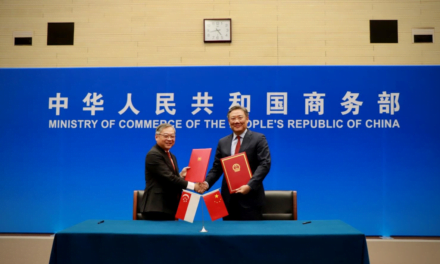The ASEAN manufacturing sector saw conditions improve at a slower rate in April, according to data released on Thursday, as job shedding emerged.
“New orders rose at a quickened pace, signaling a further improvement in demand trends. Growth in output remained solid overall, despite the upturn easing slightly,” said Maryam Baluch, an economist at S&P Global Market Intelligence, in a release on Thursday.
The headline S&P Global ASEAN Manufacturing Purchasing Managers’ Index came in at 51.0 in April, lower than March’s reading of 51.5. Anything below 50.0 signals that the sector contracted during that month, while anything above indicates expansion.
Downturn in employment
“While firms remain optimistic about future output, sentiment slipped to the joint weakest in almost four years, equal with that seen in July 2023,” said Baluch.
“Further discouraging was the return to job shedding. Employment fell for the first time since October 2023, and at the fastest rate in 29 months.”
The downturn in employment was the most severe since November 2021.
“Anecdotal evidence from our surveys indicated that resignations were often mentioned by panelists as a reason for the fall in headcounts in the ASEAN manufacturing sector,” Jingyi Pan, economics associate director at S&P Global Market Intelligence, told Diplomatic Network (Asia) in an interview on Thursday.
S&P Global noted that the drop in employment levels came despite capacity pressures continuing to build, with backlogs rising at a quicker pace.
“Some firms also revealed that they have sufficient workforce capacity to cope with the modest increase in backlogged orders,” Pan said.
“Altogether, the latest data indicated that while the volume of outstanding work rose alongside manufacturing new orders in the ASEAN region, hinting at sustained output growth in the near term, the pressure on capacity have yet to reach a level to induce firms to quickly raise staffing levels.”
Closer look at the ASEAN manufacturing sector
Indonesia’s manufacturing PMI registered 52.9 in April, down from 54.2 a month before.
“Overall, April was another positive month for the Indonesian manufacturing economy, with output and new orders rising since March at decent rates amid reports of positive demand conditions. Firms continued to bolster buying activity and built their stocks higher in anticipation of growth in the months ahead,” said S&P Global Market Intelligence Economics Director Paul Smith in a separate release.
“However, there was a little devil in the survey details. Export sales were down again, whilst growth rates in production and new orders both fell.”
The headline figure for the Philippines improved to 52.2 in April from 50.9 in March.
“A quicker rate of expansion was observed for new orders, which in turn triggered a renewed and solid rise in production. Additionally, business from overseas markets also expanded at a stronger rate,” said Baluch in a different release.
“With production requirements rising, hiring and purchasing activity remained in growth territory. Moreover, stock building became more widespread in anticipation of greater future output.”
Manufacturers in Vietnam recorded a PMI of 50.3 in April, rising back above the neutral point into growth territory from 49.9 a month before.
“There was a welcome return to growth of new orders in the Vietnamese manufacturing sector during April following recent weakness,” said Andrew Harker, another economics director at S&P Global Market Intelligence, in a separate release.
“There were some signs that the extent of the rebound perhaps took firms by surprise given that they had made the decision to release workers following the recent period of muted demand conditions, thus resulting in a build-up of backlogs. We could therefore see some of these workers brought back in the near future.”
Myanmar’s manufacturing sector headline figure ticked up for the fourth month in a row to 49.9 in April. This was compared to 48.3 in March.
“Both output and new orders returned to growth for the first time in seven months. However, given the delicate political and economic state of the country, the revival in demand could prove short-lived. Firms were hesitant to expand their capacity and instead reduced their buying activity, and markedly depleted their holdings,” said Baluch in another release.
“Moreover, the ongoing fighting between the military government and insurgent militias has heavily weighed on the economy. Trades routes have been impacted, which in turn is resulting in longer delivery times for inputs.”
In Malaysia, manufacturers saw conditions worsen in April, albeit at a slower pace, with a headline figure of 49.0. This was higher than March’s figure of 48.4.
“Evidence is currently pointing to demand conditions moving on an upward trajectory, given the softer moderations in production, new business and purchasing,” said Usamah Bhatti, an economist at S&P Global Market Intelligence, in Malaysia’s PMI release.
“Better still, manufacturers will be buoyed by the renewed expansion in new export sales, with the rate of growth the strongest recorded in three years.”
Thailand’s manufacturing sector remained in contraction in April with a headline figure of 48.6, worsened from 49.1 a month prior.
“Business conditions in the Thai manufacturing sector deteriorated for a survey record-equaling ninth month running in April, with the current downturn matching the length of the pandemic-related contraction that ran from January to September 2020,” said Trevor Balchin, an economics director at S&P Global Market Intelligence, in a separate release.
“The PMI fell further below the no-change mark of 50.0 in April due to a sharper decline in new orders, a renewed drop in output and steeper cut to input inventories.”
Outlook
Looking ahead, external demand is still under threat from global economic powerhouses maintaining higher interest rates in a bid to keep inflation under control.
“April’s PMI data signaled that business optimism eased in various ASEAN economies with concerns surrounding the impact from elevated interest rates and inflation affecting some manufacturers’ sentiment,” Pan told DNA.
This is stemming from worries that high interest rates and rising costs may dampen the recovery in global goods demand, thereby limiting output in the year ahead.”
The S&P Global ASEAN manufacturing PMI is compiled by S&P Global from responses to monthly questionnaires sent to purchasing managers in panels of manufacturers in Indonesia, Malaysia, Myanmar, the Philippines, Singapore, Thailand and Vietnam, totaling around 2,100 manufacturers. These countries account for 98% of ASEAN manufacturing value added, according to World Bank world development indicator.
Data for the PMI were collected between April 4 and 24.






